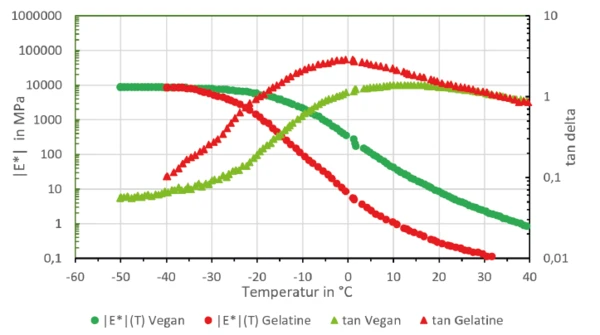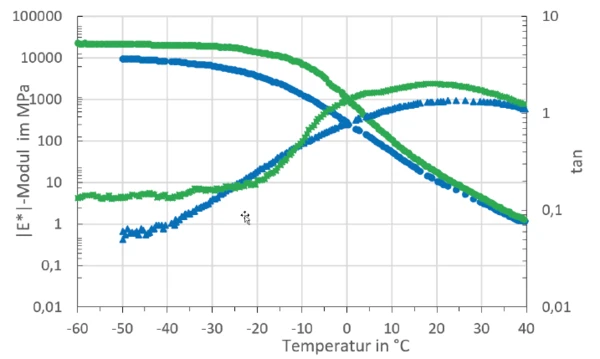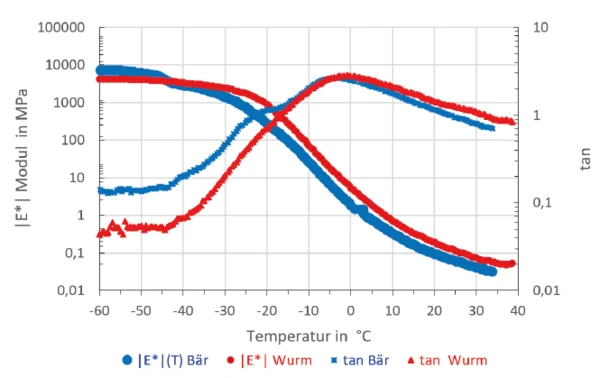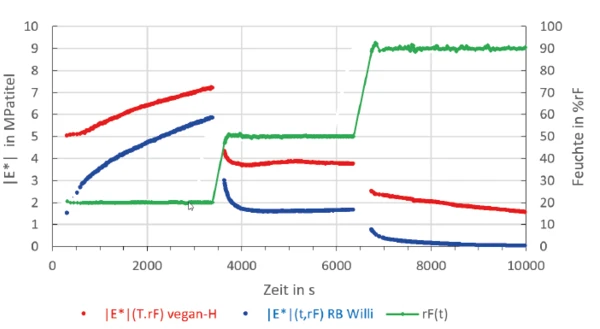Introduction
Fruit gummies are delicious and taste good throughout the year, be it in summer or winter, in the desert at 50°C or at the North Pole at -40°C. It would be unpleasant if these “sweet treats” were to stick together at high temperatures and form a sort of cohesive, sticky mass – or if a tooth were to fall by the wayside when biting on them in the cold. These examples make it clear that: Fruit gummies seem to exhibit a broad spectrum of elastic properties, varying between soft and hard and also strongly influenced by temperature. Dynamic mechanical analysis is employed for the characterization of visco-elastic properties. When coupled to a humidity chamber, the influences of drying and humidification on their mechanical behavior can also be recorded.
What Mechanical Behaviors Do Fruit Gummies from Different Climatic Zones Exhibit
Fruit gummies from the following countries were available for investigation:
- Germany
- The Netherlands
- Australia
- New Zealand
- Russia
Along with the classic, gelatin-based fruit gummies, also vegan types are included in the studies. The dynamic-mechanical behavior of all types will be recorded and compared at different temperatures. The DMA measurements will be carried out using a NETZSCH DMA Eplexor® connected to a Hygromator (optional humidity generator).
Gelatin, Its Origin, Functional Properties and Alternatives
Traditionally, gelatin [1, 2] is the main component of fruit gummies. It essentially thickens the flavoring liquid ingredients and, when used properly, provides the right melt and firmness-of-bite as well as Melting Temperatures and EnthalpiesThe enthalpy of fusion of a substance, also known as latent heat, is a measure of the energy input, typically heat, which is necessary to convert a substance from solid to liquid state. The melting point of a substance is the temperature at which it changes state from solid (crystalline) to liquid (isotropic melt).melting temperature suitable for consumption. In general, the “gummy animals” are poured and – prior to the transition into the visco-elastic phase – exist in molten form at the end of the molding process.
Gelatin is found not only in fruit gummies, but also in many other food products, e.g., low-calorie foods, yogurt, mayonnaises, aspics, meat pastes and many sweets. Historically, gelatin has also been used as a glue for thousands of years.
Gelatin is a natural food that consists mainly of collagen protein. Proteins perform three very different functions in living organisms, a) as structural proteins (= scleroproteins), b) as membrane proteins and c) as globular proteins (= spheroproteins). The collagenous version is a member of the scleroproteins and consists of 3 interlaced polypeptide chains (triple helix). When these chains cluster, collagen fibrils are formed; these actually become 3-dimensional networks due to cross-links that emerge between the triple helices and thus mechanically stabilize themselves.

The Decomposition reactionA decomposition reaction is a thermally induced reaction of a chemical compound forming solid and/or gaseous products. decomposition of collagen into individual polypeptide chains is necessary for the production of gelatin. Due to the insolubility of the crosslinking in water, this is a complex process that requires the use of chemicals. +
Gelatin production starts with collagen of animal origin. The animal proteins originate from bones or are taken from lower skin layers. Viewed at the microscopic level, collagen features the helix-like structures that are then softened in a chemical-thermal process so that they can be separated (known as maceration). The result is “demineralized” scrap, called ossein, which is the actual raw material from which gelatin is made.
Gelatin production allows different gelling strengths to be realized for various applications. The gelling strength is described by the “Bloom number”. Since the gelling strength, and thus the Bloom number, depend on temperature, the most suitable gelatin can be selected for a given product. For firmer fruit gummies, gelatin with a higher Bloom value is used than for softer types, which contain low-Bloom gelatin.
Gelatin is a hydrocolloid and can both bind water and swell in water. It thickens, gels, stabilizes, is extremely elastic and exhibits thermoreversible behavior; i.e., gelatin gels when cooled and melts when heated. This property is also used in the production of “gummy bears” and was investigated and evaluated in the measurements carried out here. The Melting Temperatures and EnthalpiesThe enthalpy of fusion of a substance, also known as latent heat, is a measure of the energy input, typically heat, which is necessary to convert a substance from solid to liquid state. The melting point of a substance is the temperature at which it changes state from solid (crystalline) to liquid (isotropic melt).melting point is also of particular importance to the consumer. After all, the “rubber animal” must melt in the mouth while still having a certain firmness.
The search for alternatives – binders of pure plant origin that feature properties similarly favorable to the ones found in gelatin – has begun, but a full replacement has not yet been found. There is a need for routine testing methods to better describe the alternative binders and their effect on the material [1], [2]
The following materials, among others, are currently being used as binders of pure plant origin, with the aim of replacing gelatin [3]:
- Agar-Agar: Gelatin substitute
- Aquafaba: Thick cooking water of plant-base chickpeas, beans and other legumes; egg substitute
- Pectin: Soluble fiber and the plant-based gelling agent potato starch: binders
- Corn starch: Substitute for starch, generally glutenand lactose-free
- Psyllium husks: Plant-based swelling agent
- Sago: Granulated starch from manioc and potatoes; tasteless thickening agent
- Locust bean (gum): Natural thickening agent
- Gear gum: Thickening and binding agent (E 412)
- Carrageen: Plant-based gelling and thickening agent (E407), obtained from red algae
- Alginate: Thickening, gelling and coating agent (E 400 to E 405), obtained from algae
- Xanthan gum: Naturally occurring polysaccharide, additive produced from bacteria (E 4015) for use as a gelling and thickening agent
- Arrowroot starch: Gluten-free binding agent; egg substitute
These alternatives are also hydrocolloids like gelatin. They are used in the food industry because of their functional properties; these properties, however, are not so comprehensive as to enable a general substitution of gelatin with them [2].
Since vegan fruit gummies also use binders that have been uncommon so far, and their effect is not yet well understood, there is a need in this field to include products with vegan binders in the investigations.
Results of the Dynamic-Mechanical Test Using the NETZSCH GABO Eplexor® 500 N
Insofar as they were available in shapes that could be easily investigated in the tensile test, fruit gummies were selected accordingly. Others were punched into a shape suitable for testing when in a cooled state.
Changes in cross-section during testing and cross-sectional areas that cannot be accurately recorded for irregularly shaped specimens do not affect damping and hence the softening temperature.
Measurement Parameters
In the first part of the test, temperature sweeps in the range from approx. -60°C to +40°C were carried out on all fruit gummy samples using the DMA Eplexor® in order to be able to compare the temperaturedependent stability (complex modulus of elasticity or just E modulus) and the associated visco-elasticity of the different fruit gummies. To this end, the samples were initially cooled to approx. -60°C in the test instrument. To set a constant temperature in the sample, an IsothermalTests at controlled and constant temperature are called isothermal.isothermal phase of 15 min is set in each case prior to the measurement, followed by a measurement at a heating rate of 0.5 K/min. The temperature measurements are carried out close to the sample with the chamber thermometer, which is located in a sample chamber with intensive air circulation.
In the second part of the experiment, the dynamicmechanical behavior of a vegan sample from Germany and a gelatin-based sample from the Netherlands is investigated during drying and under moisture absorption in the Eplexor®, equipped with a Hygromator (humidity chamber).
Temperature-Dependent Behavior of Fruit Gummies
The German gummy bears are available as vegan (green, called “strips”) and gelatin-based (red, called “French fries”) for the DMA measurements.
It is noticeable (figure 1) that the vegan fruit gummies exhibit a higher Young’s modulus at all temperatures, i.e., they are stiffer than the gelatin-based gummies. Softening of the vegan strips (green curve, Tg = 11.6°C) furthermore occurs at higher temperatures than the gelatin-based French fries (red curve, Tg= -0.4°C).
This objective finding also corresponds to the sensory results from biting and tasting: The vegan samples are firmer to the bite while the gelatin-based samples taste more intense when melted.

Dutch Gummy Bears
From the Netherlands, gelatin-based versions are available for testing. The partly irregular geometries of the gummy bears are shaped into sample form by punching when in a cooled state. In handling, these products stand out as relatively stiff fruit gummies. The softening points measured are in the range of -6°C to 0°C.
Figure 2 shows the different measurement curves of |E*| modulus and damping. The soft gummy (blue curve) exhibits differences in the softening temperature (-2.4°C) as compared to the other two fruit gummy types, Liane- Cassis (-5.1°C, red curve) and Strawberry (-4.9°C, green curve). That is why the soft gummy sample features by far the broadest damping curve and the earliest drop in the Young’s modulus as pertains to temperature. Thus, the soft gummy sample has the lowest damping in the room temperature range of all the samples being compared, and the material appears softer to the consumer than both Strawberry and Liane-Cassis.
While the damping is very similar for the Liane-Cassis and Strawberry types, the E modulus of the Strawberry is always higher than that of the Liane-Cassis, which is also reflected in the firmness upon biting.
The lower damping (tan δ) of the Liane-Cassis sample (red curves) can be seen in practice by virtue of a longer melting and deformation process than that of the Strawberry (green curve). In addition, Liane-Cassis exhibits a more intensive adhesive effect to the teeth.

Australian and New Zealand Vegan Samples
Both samples are offered on a market with high average outdoor temperatures, placing special demands on the dimensional stability and stickiness of the fruit gummies. Both samples are available in cuboid or foil form already suited for the tensile test, and only need to be either cut or additionally folded to adjust sample thickness for performing the test. While one sample (green curves) is specifically designated as vegan, the second sample (blue curves) does not explicitly assert this claim.
It’s obvious (figure 3) that the Oceanic-region products feature the highest softening temperatures (19.6°C and 24.3°C) of all the fruit gummies investigated. In particular, the cuboidal samples are relatively stiff up to the freezing point and have the highest E moduli.

Russian Gelatin-Based Fruit Gummies for Cold Climatic Regions
The two Russian gelatin-based fruit gummies investigated here are in the shape of bears (blue curves) and worms (red curves). The bear shape required punching, while the worms could be directly inserted into the DMA. Although softening of the worms starts at slightly higher (Tg = -0.9°C, red curve) temperatures than that of the bears (Tg = -4.4°C, blue curve), the two exhibit similar stiffness at the time of softening.
The E modulus of the bears at serving temperatures is lower than that of the worms (blue curves, figure 4) due to the material. The worms soften at slightly higher temperatures (3.5°C, red curves) than the bears. Accordingly, the gustatory properties of the two fruit gummy types are also very similar.

Moisture-Dependent Behavior of Fruit Gummies
The moisture-dependency of the samples is investigated, as for the temperature sweeps, in tensile mode at 35°C. The temperature is held constant during the entire experiment.
In the first step of the experiment, the vegan German and Dutch gelatin-based samples are exposed to a chamber humidity of 20% RH, which is generated and kept constant by the NETZSCH GABO Hygromator (humidity generator).
This step corresponds to a drying process to get from ambient humidity, which in these countries is about 50% to 60% RH depending on the season, to a “quasi” dried condition at 20% RH. For this test series, the fruit gummies to be tested should be available in a dried, identical moisture state for comparison purposes. To this end, the two samples were dried for approx. 1 h and the temporal course of their Young’s modulus was recorded. The samples dried this way are then also subjected to a chamber humidity of 50% for about one hour and then to a chamber humidity of 90% for another hour. The resulting time-dependent changes in the Young’s modulus and the chamber humidity prevailing at each point in time are shown in figure 5 for a vegan (red curves) and a gelatin-containing sample (blue curves).
Shown in figure 5 is similar temporal behavior for the vegan and gelatin-based fruit gummies, with the vegan types always exhibiting higher E moduli and lower moisture sensitivity in the present investigations. Common to both is an increase in E modulus upon drying (here at 20% RH) and a decrease upon exposure to moisture (here at 50% RH and 90% RH). For the specimens dried at 20% RH, humidification is already exhibited upon removal from storage at 50% RH, as shown by the course of the E modulus.

Summary
The NETZSCH DMA Eplexor® offers a routine procedure for the evaluation of consumer-relevant product properties of foods such as fruit gummies, thus serving for product improvement and new development.
The temperature dependencies of the E modulus (stiffness) and damping are closely related to the firmnessto- bite and melting behavior of the fruit gummies. Knowledge of the moisture dependencies, on the other hand, is of greater value for evaluating the storage conditions.
For the development of further fruit gummy types, especially with new binders for vegan customers, dynamic-mechanical analysis offers the ability to record both thermal and mechanical properties in the laboratory in advance, and thus to launch the products on the market in a more targeted manner and faster. Storage and processing conditions along with the parameters of moisture and temperature can furthermore be simulated by means of DMA measurements.